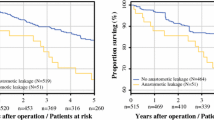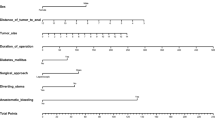Abstract
Background
This study was designed to apply modern statistical methods to evaluate risk factors for anastomotic leakage after rectal cancer resection in a retrospective cohort of patients who received a colorectostomy. Whereas a diverting stoma and tumor height are considered proven risk factors for anastomotic leakage, a lack of evidence about additional risk factors persists.
Methods
In a single-center study, 527 consecutive patients who received a colorectostomy after rectal cancer resection between 1991 and 2008 were retrospectively assessed. In addition to traditional uni- and multivariate regression, locally weighted scatterplot smoothing (LOWESS) regression and bootstrap analysis were applied to increase internal validity.
Results
Anastomotic leakage occurred in 70 patients (13.3%; 95% confidence interval (CI), 10.5–16.5%) and mortality was 2.5% (95% CI, 1.4–4.2%). Diverting stoma (odds ratio (OR), 0.4; 95% CI, 0.17–0.61) and tumor height (OR, 0.88; 95% CI, 0.8–0.94) were proven to be protective. Neoadjuvant radiotherapy (OR, 2.15; 95% CI, 1.58–4.24) and intraoperative blood loss (OR, 1.05; 95% CI, 1.02–1.09) had a derogatory effect. Bootstrap analysis identified pre-existing vascular disease (95.5%), more advanced UICC stage III or IV tumors (95.7% or 91.5%, respectively), and intraoperative (96.1%) and postoperative (99.4%) blood substitution as harmful. Both intraoperative and postoperative blood substitution caused a dose-dependent increase in risk.
Conclusions
Applying statistical resampling methods identified intraoperative blood loss, blood substitution, vascular disease, and advanced UICC stage as risk factors for anastomotic leakage. Greater distances between the tumor and the anal verge and performance of a diverting stoma were associated with a decreased risk of anastomotic leakage.



Similar content being viewed by others
References
Nastro P, Beral D, Hartley J, Monson JR. Local excision of rectal cancer: review of literature. Dig Surg. 2005;22:6–15.
Ptok H, et al. Impact of anastomotic leakage on oncological outcome after rectal cancer resection. Br J Surg. 2007;94:1548–54.
Kingham TP, Pachter HL. Colonic anastomotic leak: risk factors, diagnosis, and treatment. J Am Coll Surg. 2009;208:269–78.
Jestin P, Pahlman L, Gunnarsson U. Risk factors for anastomotic leakage after rectal cancer surgery: a case-control study. Colorectal Dis. 2008;10:715–21.
Makela JT, Kiviniemi H, Laitinen S. Risk factors for anastomotic leakage after left-sided colorectal resection with rectal anastomosis. Dis Colon Rectum. 2003;46:653–60.
Vignali A, et al. Factors associated with the occurrence of leaks in stapled rectal anastomoses: a review of 1,014 patients. J Am Coll Surg. 1997;185:105–13.
Choi HK, Law WL, Ho JW. Leakage after resection and intraperitoneal anastomosis for colorectal malignancy: analysis of risk factors. Dis Colon Rectum. 2006;49:1719–25.
Peeters KC, et al. Risk factors for anastomotic failure after total mesorectal excision of rectal cancer. Br J Surg. 2005;92:211–6.
Efron B. Bootstrap methods: another look at the jackknife. Ann Stat. 1979;7:1–26.
Boos DD. Introduction to the bootstrap world. Stat Sci. 2003;18:168–74.
Altman DG, Andersen PK. Bootstrap investigation of the stability of a Cox regression model. Stat Med. 1989;8:771–83.
Austin PC, Tu JV. Bootstrap methods for developing predictive models. Am Stat. 2004;58:131–7.
Cleveland WS, Devlin SJ. Locally-weighted regression: an approach to regression analysis by local fitting. J Am Stat Assoc. 1988;83:596–610.
Zaheer S, et al. Surgical treatment of adenocarcinoma of the rectum. Ann Surg. 1998;227:800–11.
Knight CD, Griffen FD. An improved technique for low anterior resection of the rectum using the EEA stapler. Surgery. 1980;88:710–4.
Dindo D, Demartines N, Clavien PA. Classification of surgical complications: a new proposal with evaluation in a cohort of 6336 patients and results of a survey. Ann Surg. 2004;240:205–13.
Clavien PA, et al. The Clavien-Dindo classification of surgical complications: five-year experience. Ann Surg. 2009;250:187–96.
Agresti A, Coull BA. Approximate is better than “exact” for interval estimation of binomial proportions. Am Stat. 1998;52:119–26.
Altman DG, Bland JM. Absence of evidence is not evidence of absence. BMJ. 1995;311:485.
Ulrich AB, Seiler C, Rahbari N, Weitz J, Buchler MW. Diverting stoma after low anterior resection: more arguments in favor. Dis Colon Rectum. 2009;52:412–8.
Matthiessen P, Hallbook O, Rutegard J, Simert G, Sjodahl R. Defunctioning stoma reduces symptomatic anastomotic leakage after low anterior resection of the rectum for cancer: a randomized multicenter trial. Ann Surg. 2007;246:207–14.
Gunnarsson U, Karlbom U, Docker M, Raab Y, Pahlman L. Proctocolectomy and pelvic pouch—is a diverting stoma dangerous for the patient? Colorectal Dis. 2004;6:23–7.
Karliczek A, et al. Surgeons lack predictive accuracy for anastomotic leakage in gastrointestinal surgery. Int J Colorectal Dis. 2009;24:569–76.
Law WL, Chu KW. Anterior resection for rectal cancer with mesorectal excision: a prospective evaluation of 622 patients. Ann Surg. 2004;240:260–8.
Valero G, et al. Neoadjuvant radiation and chemotherapy in rectal cancer does not increase postoperative complications. Int J Colorectal Dis. 2003;18:495–9.
Buie WD, MacLean AR, Attard JA, Brasher PM, Chan AK. Neoadjuvant chemoradiation increases the risk of pelvic sepsis after radical excision of rectal cancer. Dis Colon Rectum. 2005;48:1868–74.
Folkesson J, Nilsson J, Pahlman L, Glimelius B, Gunnarsson U. The circular stapling device as a risk factor for anastomotic leakage. Colorectal Dis. 2004;6:275–9.
Alves A, et al. Factors associated with clinically significant anastomotic leakage after large bowel resection: multivariate analysis of 707 patients. World J Surg. 2002;26:499–502.
Camma C, et al. Preoperative radiotherapy for resectable rectal cancer: a meta-analysis. JAMA. 2000;284:1008–15.
Pettersson D, et al. Interim analysis of the Stockholm III trial of preoperative radiotherapy regimens for rectal cancer. Br J Surg. 2010;97:580–7.
Law WI, Chu KW, Ho JW, Chan CW. Risk factors for anastomotic leakage after low anterior resection with total mesorectal excision. Am J Surg. 2000;179:92–6.
Sorensen LT, et al. Smoking and alcohol abuse are major risk factors for anastomotic leakage in colorectal surgery. Br J Surg. 1999;86:927–31.
Miki C, et al. Perioperative allogeneic blood transfusion, the related cytokine response and long-term survival after potentially curative resection of colorectal cancer. Clin Oncol (R Coll Radiol). 2006;18:60–6.
Konishi T, Watanabe T, Kishimoto J, Nagawa H. Risk factors for anastomotic leakage after surgery for colorectal cancer: results of prospective surveillance. J Am Coll Surg. 2006;202:439–44.
Rullier E, et al. Risk factors for anastomotic leakage after resection of rectal cancer. Br J Surg. 1998;85:355–8.
Martel G, et al. Neoadjuvant therapy and anastomotic leak after tumor-specific mesorectal excision for rectal cancer. Dis Colon Rectum. 2008;51:1195–201.
Sources of financial support
None.
Author information
Authors and Affiliations
Corresponding author
Rights and permissions
About this article
Cite this article
Warschkow, R., Steffen, T., Thierbach, J. et al. Risk Factors for Anastomotic Leakage after Rectal Cancer Resection and Reconstruction with Colorectostomy. A Retrospective Study with Bootstrap Analysis. Ann Surg Oncol 18, 2772–2782 (2011). https://doi.org/10.1245/s10434-011-1696-1
Received:
Published:
Issue Date:
DOI: https://doi.org/10.1245/s10434-011-1696-1




